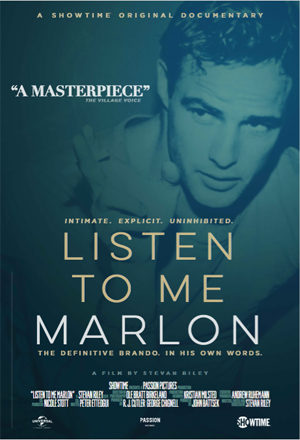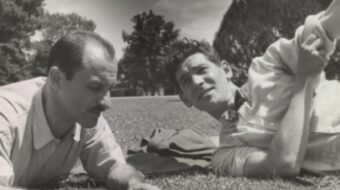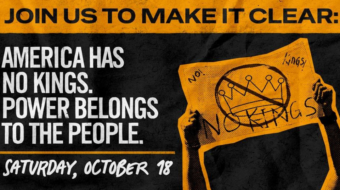
Marlon Brando may have died in 2004 but he has not gone gently into Dylan Thomas’ good night. He’s back!
In the interests of full disclosure your humble scribe should let you know that Brando is his favorite actor. Having said that, Stevan Riley’s great new documentary Listen to Me Marlon, about the stage and screen legend, is a must-see for viewers interested in film/theater history, the art of acting, celebrity activism and, of course, Brando, the man and artist.
Riley had access to a hitherto previously unknown, privately held treasure trove of audiotapes the prolific Brando accumulated over the years for various purposes, including to prepare and research roles; self-hypnosis; recitations of Shakespeare monologues; etc. In these wide-ranging ruminations, Brando reflects on growing up miserable in Nebraska, the son of alcoholics; method acting; his family; many of his movies; his romantic life; and his activist radical politics.
Riley’s doc explores and expresses the actor’s inner and outer life through the audiotapes, spoken by Brando himself with that distinctive voice – in effect Brando is posthumously narrating the film, literally having the last word. Of course, there are extensive still photos and clips – not only from Marlon’s movies but also of his Stanislavsky system guru, Stella Adler. Some of those who worked with Brando, such as Bernardo Bertolucci, who directed Last Tango in Paris (1972), also are heard.
In archival and news footage we see Brando’s battles in court – briefly with his ex-wife Anna Kashfi and their custody clash over son Christian Brando and then, unfolding like a Shakespearean tragedy, what Brando called “the messenger of misery” arriving at his home: Christian’s shooting of his Tahitian half-sister Cheyenne’s Polynesian lover, Dag Drollet, at Marlon’s Mulholland Drive perch.
There are also home movies of Brando in happier days at Tahiti and Tetiaroa, the nearby atoll that the reclusive star bought as a private getaway. Although the documentary, which is generally sympathetic to its subject (perhaps a condition of having access to the tapes and for making the film?), doesn’t go into it, the killing of Dag apparently prevented Brando for the last 15 years or so of his life from returning to French Polynesia, where he would have been under French jurisdiction and subject to questioning. By building a resort at Tetiaroa the oft-contradictory celebrity brought tourists to his supposed refuge. And Brando’s eco-obsession to transform Tetiaroa into an environmental paragon failed, marring the previously pristine paradise with abandoned rotting structures. (I know – I saw them there in the 1990s.)
Intriguingly, Riley includes a high tech version of the actor who played Kryptonian scientist Jor-El in Superman (1978). According to press notes, “Marlon Brando had his face digitized in the 1980s by VFX supremo Scott Billups using cutting edge software of the time called Cyberware… Passion Pictures put their best animation team on the job and under Stevan [Riley’s] guidance, they used the original files and brand new techniques and software to create a stylized animated version 3D head. The technique effectively maps facial movements, so that the face directly corresponds to some carefully chosen sequences of Marlon’s personal audio archive.”
Among the most absorbing of Marlon’s musings are his political views. The doc shows that this son of alcoholics and an abusive father developed an inherent sense of identification with outsiders and that the man who would play a Mafia chieftain in 1972’s The Godfather maintained he couldn’t stand to see the weak get pushed around. To his credit, in his finest moments Brando used his fame and fortune to support and shine a light on the oppressed. In Listen the actor/activist is seen in clips at civil rights events and at the funeral of “Lil’ Bobby” Hutton, the teenage Black Panther killed by Oakland police in a shootout which involved Eldridge Cleaver. Brando is shown standing beside Panther co-founder and chairman Bobby Seale. Martin Luther King also appears in a different clip.
Brando is better known for his stance on Native American issues, although he once rather pithily pointed out that when it comes to who’s more oppressed – blacks, Indians, etc. – “it’s not an ouch contest.” Brando is heard recounting putting himself “on the line” during an armed land struggle at Kenosha, Wisconsin, pitting Natives against National Guardsmen, discussing being “four feet from death” as bullets whistled near him.
Of course, in what is arguably the Academy Awards ceremony’s greatest political moment, Brando sent traditionally-garbed Sacheen Littlefeather to decline his Godfather Oscar, due to Hollywood’s disparaging treatment of America’s aboriginal people with decades of celluloid stereotypes. Part of this unforgettable moment, which raised the spirits of indigenous occupiers at Wounded Knee and finally gave some airtime to Native Americans, is in Listen. (The doc fails to mention that ironically, the Italian Civil Rights League – which may well have been a Mafia front – criticized Brando, a non-Italian, for maligning the image of Italians and Italian-Americans in The Godfather.)
Intercut with clips from movies such as John Ford’s Drums Along the Mohawk (1939), Listen includes a bearded Brando denouncing Tinseltown’s depiction of Natives as “savages” during a 1970s appearance on Dick Cavett’s ABC-TV talk show, proclaiming: “Everything we are taught about the American Indian [by Hollywood] is wrong. There have been 400 treaties written by the United States, in good faith with the Indians, and every single one of them has been broken. We like to see ourselves as perhaps John Wayne sees us, that we are a country that stands for freedom, for rightness, for justice. It just simply doesn’t apply. And we were the most rapacious, aggressive, destructive, torturing, monstrous people who swept from one coast to the other, murdering and causing mayhem among the Indians.” When a member of Cavett’s audience applauds Brando’s challenge to American exceptionalism, he quips there was one Indian in the studio and adds: “But that isn’t revealed because we don’t like that image of ourselves.”
In what appears to be an aside extracted from Brando’s tapes he goes on to ponder: “We’re all living on stolen land.” However, Brando himself was the white American proprietor of a Polynesian atoll that had been the preserve of Tahitian royalty – although, to be fair, ownership of Tetiaroa (where there is now a large resort called “The Brando”) appears to have been passed down to his Tahitian family. In any case, perhaps due to fears about possible deportation, the outspoken pro-Indian activist rarely, if ever, spoke up against French colonialism in Polynesia and France’s nuclear testing at another atoll, Moruora.
Be that as it may, Listen is a stellar, riveting biography. What Brando aficionados may most appreciate is Marlon’s mulling over of acting and his stage and screen career. It’s fascinating to hear Brando reveal what he thought about in order to unleash his pent-up explosive rage in A Streetcar Named Desire, which catapulted him to fame on Broadway and then Hollywood, with Elia Kazan’s 1951 big screen adaptation. It is an illuminating example of how the Stanislavsky method works.
Interestingly, Kazan, the director who is considered to have played such an influential role in shaping Brando’s theater and movie career, is almost completely nonexistent in Listen. Perhaps this is part of the price the late Kazan is continuing to pay for being what Victor Navasky (in his book Naming Names) called “the quintessential informer” during the Hollywood Blacklist? In any case, the doc neglects to mention that On the Waterfront (1954), for which Brando won his first Academy Award, was a propagandistic apologia for snitching on La-La-Land leftists to the House Un-American Activities Committee, made by Kazan and fellow “friendly witness” screenwriter Budd Schulberg.
Brando’s stardom brought a fame and idolatry that, he says, discomforted and discombobulated him offstage and offscreen. In Listen he expresses self-loathing for stooping so low as to be in what he regarded as his worst flick, Candy (1968), made during a lengthy nadir in his career. Brando often derided the acting profession – but listen, Marlon, if your dad abused you and repeatedly called you worthless, it doesn’t matter if you make millions, become famous, win Oscars, sleep with endless groupies: One is still likely to feel like a zero. However, in what may be the documentary’s most rewarding moment, Brando has what may be an epiphany as he discusses how worthy his avocation can be.
My favorite moments in Listen to Me Marlon resonate personally: Shots of his daughter Cheyenne Brando when she was a little girl. In 1976 my Tahitian vahine, Mareva Salmon, was farewelling me at Faaa Airport when she told me: “Adi – you look. It is Tarita.” Mareva’s mom, Ruita Salmon, had appeared with Tarita in 1962’s Mutiny on the Bounty. Tarita was waiting with Brando’s go-to guy in Tahiti, Dick Johnson, and several children bearing more leis than I had ever seen. Among the youngsters was adorable blonde haired Cheyenne, daughter of Tarita and Marlon.
They were waiting at the airport to welcome Dad back from the Philippines, where he had been shooting Apocalypse Now. I greeted Johnson, whom I’d previously met, and was introduced to Tarita, who was still radiantly beautiful. As is the French custom, it was Tahitian-style to kiss strangers on both cheeks but I went straight for the luscious lips of the co-star of Mutiny on the Bounty. Alas, Tarita was too swift and literally turned the other cheek.
It turned out that due to Apocalypse’s overruns, Brando was a no show, and in those days before email, placing a phone call from the Philippines to Tahiti was difficult. I remember that holding her leis charming little Cheyenne seemed disappointed: 19 years later, after her boyfriend Dag’s death, she met her own apocalyptic fate, hanging herself in Tahiti.
So I never met my favorite actor. But I did get to kiss Tarita – on the cheek. And you should go see this compelling film.
L.A.-based reviewer Ed Rampell co-authored “The Hawaii Movie and Television Book” (see: HYPERLINK “http://hawaiimtvbook.weebly.com/” http://hawaiimtvbook.weebly.com/) and his Progressive Magazine interview with America’s former Poet Laureate is in the new book “Conversations With W.S. Merwin.”
Listen to Me Marlon
2015 95 min
Director: Stevan Riley
Writers: Stevan Riley, Peter Ettedgui (co writer)
Stars: Marlon Brando










